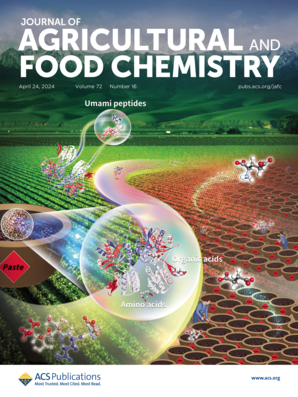比较LC-QTOF-MS/MS代谢组学在分子网络和化学计量学辅助下用于鉴定霍霍巴提取物作为天然抗菌剂和抗生物膜剂的价值。
IF 6.2
1区 农林科学
Q1 AGRICULTURE, MULTIDISCIPLINARY
引用次数: 0
摘要
荷荷巴(Simmondsia chinensis)种子因其宝贵的油在世界范围内广泛使用。荷荷巴灌木其他部分的化学成分大部分仍未被探索。本文采用液相色谱-四极杆飞行时间串联质谱(LC-QTOF-MS/MS)结合分子网络(MN)技术,分析了荷荷巴不同植物器官的水提物和甲醇提物的代谢物谱,确定了来自不同类别的104种代谢物。所有甲醇提取物对所检测的菌株均有显著的抑菌活性。亚最低抑制浓度(sub- mic)成功地抑制了金黄色葡萄球菌生物膜的形成,抑制率超过90%。0.5 MIC的种子提取物对金黄色葡萄球菌和粪肠球菌生物膜的去除率达到80%。多变量数据分析显示,生物标志物与生物活性呈正相关,主要是类黄酮、酚类化合物和西蒙斯甙。这些结果为未来研究荷荷巴籽衍生产品和其他器官副产品提供了基础。本文章由计算机程序翻译,如有差异,请以英文原文为准。
Comparative LC-QTOF-MS/MS Metabolomics Applied for Valorization of Jojoba Extracts as Natural Antimicrobial and Antibiofilm Agents Aided by Molecular Networking and Chemometrics.
Jojoba (Simmondsia chinensis) seeds are broadly used worldwide for their valuable oil. The chemical composition of the other parts of the jojoba shrub remains largely unexplored. In this work, the metabolite profiles of aqueous and methanolic extracts from different jojoba plant organs were analyzed by liquid chromatography-quadrupole time-of-flight tandem mass spectrometry (LC-QTOF-MS/MS) combined with molecular networking (MN), resulting in the assignment of 104 metabolites from different classes. All methanolic extracts evinced significant antibacterial activity against the examined bacterial strains. Subminimum inhibitory concentrations (sub-MICs) of the hull and leaf extracts successfully inhibited biofilm formation of Staphylococcus aureus with inhibition rates above 90%. The seed extract at 0.5 MIC effectively eradicated S. aureus and Enterococcus faecalis biofilms (>80%). Multivariate data analysis revealed the positively correlated biomarkers with bioactivity, primarily flavonoids, phenolic compounds, and simmondsins. These results present a ground for future research to valorize jojoba seed-derived products and byproducts from other organs.
求助全文
通过发布文献求助,成功后即可免费获取论文全文。
去求助
来源期刊
CiteScore
9.90
自引率
8.20%
发文量
1375
审稿时长
2.3 months
期刊介绍:
The Journal of Agricultural and Food Chemistry publishes high-quality, cutting edge original research representing complete studies and research advances dealing with the chemistry and biochemistry of agriculture and food. The Journal also encourages papers with chemistry and/or biochemistry as a major component combined with biological/sensory/nutritional/toxicological evaluation related to agriculture and/or food.

 求助内容:
求助内容: 应助结果提醒方式:
应助结果提醒方式:


